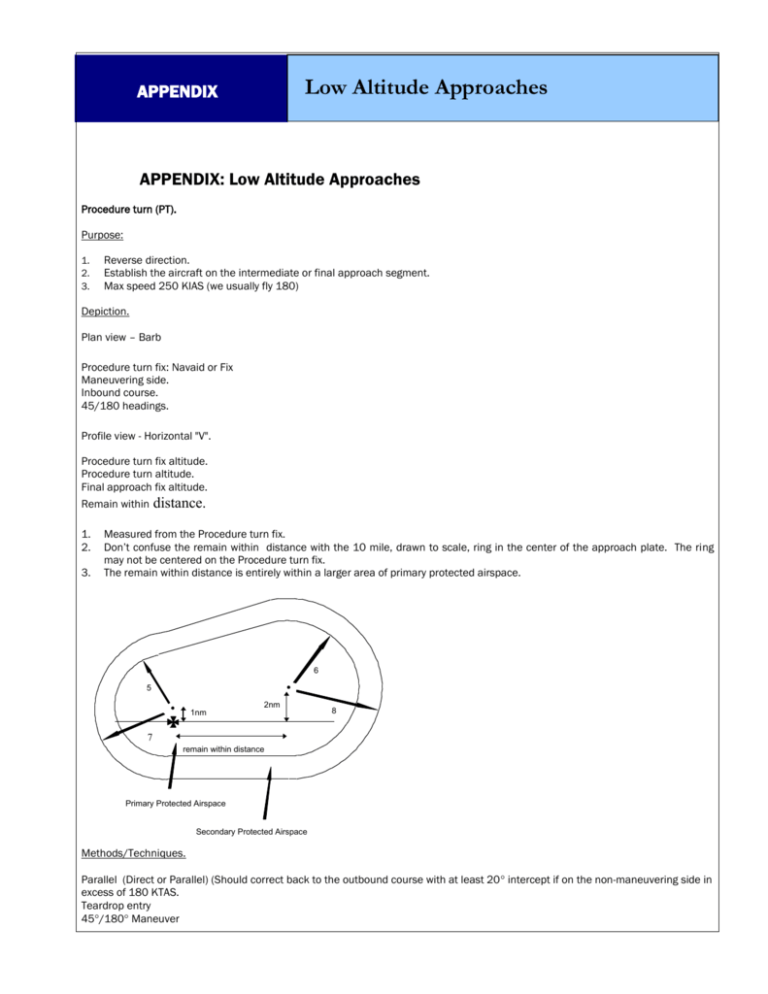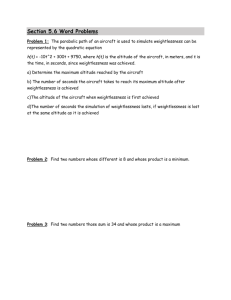APPENDIX: Low Altitude Approaches
advertisement

Low Altitude Approaches APPENDIX APPENDIX: Low Altitude Approaches Procedure turn (PT). Purpose: 1. 2. 3. Reverse direction. Establish the aircraft on the intermediate or final approach segment. Max speed 250 KIAS (we usually fly 180) Depiction. Plan view – Barb Procedure turn fix: Navaid or Fix Maneuvering side. Inbound course. 45/180 headings. Profile view - Horizontal "V". Procedure turn fix altitude. Procedure turn altitude. Final approach fix altitude. Remain within 1. 2. 3. distance. Measured from the Procedure turn fix. Don’t confuse the remain within distance with the 10 mile, drawn to scale, ring in the center of the approach plate. The ring may not be centered on the Procedure turn fix. The remain within distance is entirely within a larger area of primary protected airspace. 6 5 1nm 2nm 8 7 remain within distance Primary Protected Airspace Secondary Protected Airspace Methods/Techniques. Parallel (Direct or Parallel) (Should correct back to the outbound course with at least 20 intercept if on the non-maneuvering side in excess of 180 KTAS. Teardrop entry 45/180 Maneuver The 80/260 course reversal is not addressed in AFM 11-217 for use by Air Force pilots in FAA controlled airspace. Accomplishing the approach. General. You may use normal lead points for your turns if your heading is within 90 of the outbound track. This is particularly helpful if planning the 45/180 procedure turn. 45/180 procedure turn. Remain within distance This maneuver is done by turning 45 away from the outbound course toward the maneuvering side and then reversing direction with a turn in the opposite direction to establish a 45 intercept for the inbound course. Intercept and maintain the outbound course as soon as possible after passing the PT fix. Because of the geometry involved in the maneuver, it is very likely that the inbound course will be intercepted almost immediately after completing the 180 turn. AFMAN 11-217 specifies that timing on the 45 leg is 1+15 for categories C and higher, 1 minute for categories A and B. Timing starts upon initiating the 45 deg turn. The distance you travel outbound before starting the maneuver is entirely your choice, however, you must remain within the specified distance. As a technique, subtract (3 x Turn Radius) + 2 from the specified remain within distance to determine the maximum distance that the aircraft should travel outbound prior to initiating the 45° turn. 3TR + 2 Remain within distance Within 70 If the inbound procedure turn course is within 70 of the aircraft heading, turn outbound toward the maneuvering side to parallel the inbound procedure turn course. Not Within 70 If the inbound procedure turn course is not within 70 of the aircraft heading, turn outbound in the shorter direction to parallel or intercept the inbound course Correct back to course with at least a 20 degree intercept if on the non-maneuvering side, and TAS greater than 180 Kts. If the course is intercepted outbound, maintain the course outbound and turn toward the maneuvering side to reverse direction. * As a technique, you may use the ICAO 30 deg entry cone on each side if the Pt fix to determine if you want to fly the barb or just turn towards the maneuvering side to reverse course. Begin timing. Outbound abeam. Wings level outbound if you cannot determine the abeam position. Teardrop entry. Conveniently aligned. 30° maximum teardrop angle. If 45° was used, you might exceed protected airspace. If course guidance is available, attempt to intercept and maintain a selected teardrop course. Teardrop angle. TD angle = (120 x TR) / Leg length. Consider this technique when a longer leg length is desired. For example, a no-FAF approach. Leg length Leg length = (120 x TR) / TD angle. For a 30 teardrop, leg length = 4 TR Based on 30, 60, 90 relationship where hypotenuse = 2 times the length of the adjacent end. 60 4x 2x 90 30 10% x TAS approximates the time in seconds that it takes to fly a horizontal distance equal to 1 TR. For each TR we want to offset, we fly 2 TR on a 30° track. Since we want to offset 1 turn diameter (2TR) we fly 4 TR (or 4 x 10% of TAS in seconds). Descents. PT Fix altitude. 45/180 abeam on a parallel or intercept heading to the outbound track Otherwise abeam the procedure turn fix heading outbound. If you cannot determine when you are abeam, start your descent after completing the outbound turn. The procedure turn footprint is divided into 2 zones: the entry zone and the maneuvering zone. PT fix altitudes are normally due to ATC restrictions; however, they might also be due to an obstacle in the entry zone. In order to ensure obstacle clearance that is why you should not descend from the PT fix altitude until outbound abeam (at which point the aircraft is definitely in the maneuvering zone). PT Altitude. Established on the inbound segment. At that point, obstacle clearance is based on attempting to maintain the published inbound course. When not to fly the PT: 1. 2. 3. 4. 5. Issued an ATC clearance for a "Straight-in" approach. Initial approach is via a "No PT" routing. Established in a published or assigned holding pattern, subsequently cleared for the approach, and the holding course and the procedure turn course are the same. ATC Radar vectors the aircraft to final approach course Conducting “Timed approaches” from a holding fix. Holding in lieu of Procedure Turn. Purpose: An alternative method of reversing direction to establish the aircraft on an intermediate or final approach segment. Airspeed.: Maximum holding airspeeds apply. Entry: Holding pattern rules apply. 1. Maximum teardrop is 45. 2. No correction required if on the non-holding side. Descents 1. 2. Descent from the minimum holding altitude may be depicted in two ways: descent at the holding fix or descent on the inbound leg. Initial descent is made when the aircraft is established in the holding pattern (outbound from the IAF). 3. 4. 5. 6. 7. The TERPS holding template is not divided into entry and maneuvering zones like the Procedure Turn template. As soon as you pass the IAF you are established in the protected airspace and may descend. Subsequent descents are based on being established on the specified course. Further descent may either be on the inbound segment or on final. If descent on the inbound segment is depicted, the maximum difference between IAF and FAF altitudes will be 300 ft. Times when a HILO PT will not be flown. 1. 2. 3. 4. 5. 6. 7. Issued an ATC clearance for a "straight-in" approach. Initial approach is via a "No PT" routing. ATC radar vectors the aircraft to final approach course. Established in the published holding pattern (in lieu of procedure turn) and the aircraft is at an altitude from which the approach can be safely executed. Additional circuits of the holding pattern are neither necessary nor expected by ATC. If additional circuits are required to lose excessive altitude, request them from ATC. Conducting “timed approaches” from the holding fix. Procedural Track. Purpose: To align the aircraft on an intermediate or final segment of an IAP. Depiction. Solid black line. Courses, arcs, radials, turns, DR courses. Entry. Passing the IAF, turn in the shorter direction to intercept track. If you are within 90° you are not required overfly the IAF. Use normal lead points. If not within 90° of the track, ask for maneuvering airspace if you feel you need it. Otherwise, turn in the shorter direction to intercept the course. There might also be an arrival holding pattern that could be used to align the aircraft for the approach. Descent. 1. 2. 3. Initial descent. At the IAF descend when abeam or past on a parallel or intercept heading to the procedural track course. This puts you at the beginning of the black line correcting towards it. Obstacle clearance on the procedural track is based on the pilot attempting to maintain the black line. Subsequent descents are made when established on the next segment of the IAP. Low altitude approaches may include arc to radial and radial to arc combinations. An arc to radial altitude restriction applies only while established on that segment of the IAP. Once a lead point is reached and a turn to the next segment is begun, pilots may consider themselves established on the next segment and descend to the next applicable altitude. When an altitude restriction is depicted at a fix defined as an intersection of a radial and an arc, the restriction must be complied with no later than the completion of the lead turn associated with that fix. If the restriction is met during the lead turn, consider yourself established on the next segment, and you may continue to descend to the next applicable altitude restriction.








